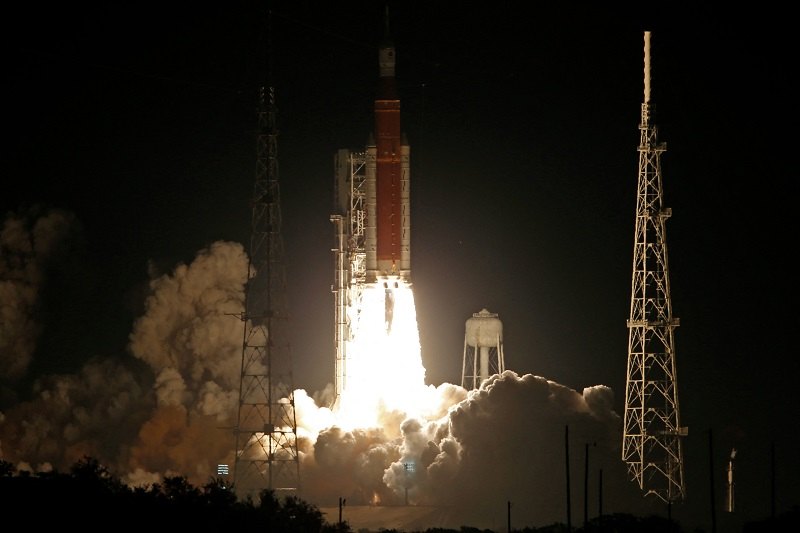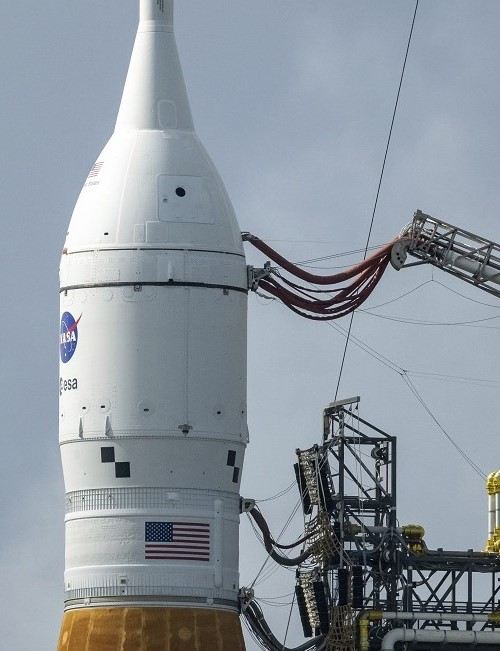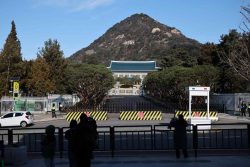
NASA’s next-generation moon rocket, the Space Launch System (SLS) rocket with the Orion crew capsule, lifts off from launch complex 39-B on the unmanned Artemis1 mission to the moon at Cape Canaveral, Florida, U.S. November 16, 2022.
16:00 JST, November 16, 2022
CAPE CANAVERAL, Fla., Nov 16 (Reuters) – NASA’s towering next-generation moon rocket blasted off from Florida early on Wednesday on its debut flight, a crewless voyage inaugurating the U.S. space agency’s Artemis exploration program 50 years after the final Apollo moon mission.
The 32-story Space Launch System (SLS) rocket surged off the launch pad from the Kennedy Space Center in Cape Canaveral to send its Orion capsule on a three-week test journey around the moon and back without astronauts aboard.
Liftoff came on the third attempt at launching the long-delayed, multibillion-dollar rocket, after 10 weeks beset by numerous technical mishaps, back-to-back hurricanes and two excursions trundling the spacecraft out of its hangar to the launch pad.
Dubbed Artemis I, the mission marks the first flight of the SLS rocket and the Orion capsule together, built by Boeing Co BA.N and Lockheed Martin Corp LMT.N, respectively, under contract with NASA.
It also signals a major change in direction for NASA’s post-Apollo human spaceflight program after decades focused on low-Earth orbit with space shuttles and the International Space Station. (See graphic)
Named for the ancient Greek goddess of the hunt – and Apollo’s twin sister – Artemis aims to return astronauts to the moon’s surface as early as 2025.
Twelve astronauts walked on the moon during six Apollo missions from 1969 to 1972, the only spaceflights yet to place humans on the lunar surface. But Apollo, born of the Cold War-era U.S.-Soviet space race, was less science-driven than Artemis.
The new moon program has enlisted commercial partners such as Elon Musk’s SpaceX and the space agencies of Europe, Canada and Japan to eventually establish a long-term lunar base as a stepping stone to even more ambitious human voyages to Mars.
The Artemis I countdown climaxed with the rocket’s four main R-25 engines and its twin solid-rocket boosters roaring to life, sending the spacecraft streaking skyward and lighting up the night sky over Florida’s central Atlantic coast.
About 90 minutes after launch, the rocket’s upper stage is designed to loft Orion out of Earth orbit on course for a 25-day flight that will bring it to within 60 miles (97 km) of the lunar surface before sailing 40,000 miles (64,374 km) beyond the moon and back to Earth.
The capsule is expected to splash down on Dec. 11.
SPACEFLIGHT STRESS TEST

A close-up view of NASA’s moon rocket at Kennedy Space Center, Monday, Nov. 14, 2022, in Cape Canaveral, Fla. Hurricane Nicole’s high winds last week caused a 10-foot section of caulking to peel away near the capsule at the top of the rocket.
Getting the SLS-Orion spacecraft off the ground was a key hurdle for the ambitious Artemis program. Its first voyage is intended to put the vehicle through its paces in a rigorous test flight, pushing its design limits to prove the spacecraft is suitable to fly astronauts.
If the mission succeeds, a crewed Artemis II flight around the moon and back could come as early as 2024, followed within a few more years by the program’s first lunar landing of astronauts, one of them a woman, with Artemis III.
Billed as the most powerful, complex rocket in the world, the SLS represents the biggest new vertical launch system NASA has built since the Saturn V of the Apollo era.
Although no people were aboard, Orion carried a simulated crew of three – one male and two female mannequins – fitted with sensors to measure radiation levels and other stresses that astronauts would experience.
A top objective is to test the durability of Orion’s heat shield during re-entry as it hits Earth’s atmosphere at 24,500 miles (39,429 km) per hour, or 32 times the speed of sound, on its return from lunar orbit – much faster than re-entries from the space station.
The heat shield is designed to withstand re-entry friction expected to raise temperatures outside the capsule to nearly 5,000 degrees Fahrenheit (2,760 degrees Celsius).
The spacecraft also is set to release a payload of 10 miniaturized science satellites, called CubeSats, including one designed to map the abundance of ice deposits on the moon’s south pole, where Artemis seeks to eventually land astronauts.
Sending astronauts to Mars, an order of magnitude more challenging than lunar landings, is expected to take at least another decade and a half to achieve.
More than a decade in development with years of delays and budget overruns, the SLS-Orion spacecraft has so far cost NASA least $37 billion, including design, construction, testing and ground facilities. NASA’s Office of Inspector General has projected total Artemis costs at $93 billion by 2025.
"News Services" POPULAR ARTICLE
-

American Playwright Jeremy O. Harris Arrested in Japan on Alleged Drug Smuggling
-

Japan’s Nikkei Stock Average as JGB Yields, Yen Rise on Rate-Hike Bets
-

Japan’s Nikkei Stock Average Licks Wounds after Selloff Sparked by BOJ Hike Bets (UPDATE 1)
-

Japan’s Nikkei Stock Average Buoyed by Stable Yen; SoftBank’s Slide Caps Gains (UPDATE 1)
-

Japanese Bond Yields Zoom, Stocks Slide as Rate Hike Looms
JN ACCESS RANKING
-

Tokyo Economic Security Forum to Hold Inaugural Meeting Amid Tense Global Environment
-

Keidanren Chairman Yoshinobu Tsutsui Visits Kashiwazaki-Kariwa Nuclear Power Plant; Inspects New Emergency Safety System
-

Imports of Rare Earths from China Facing Delays, May Be Caused by Deterioration of Japan-China Relations
-

University of Tokyo Professor Discusses Japanese Economic Security in Interview Ahead of Forum
-

Japan Pulls out of Vietnam Nuclear Project, Complicating Hanoi’s Power Plans
























